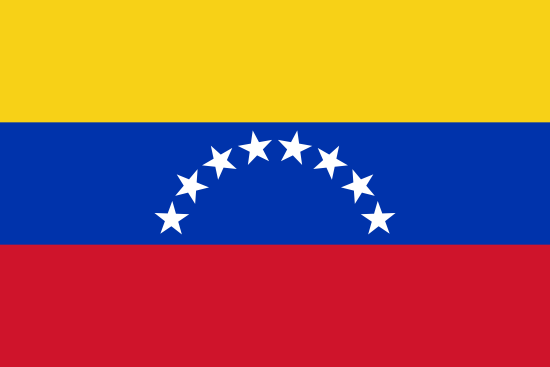Venezuela is located in northern South America and borders Brazil, Colombia and Guyana. Venezuela has coasts to the Caribbean Sea and the North Atlantic and shares maritime borders with Aruba, the Netherlands Antilles and Trinidad and Tobago.
| Capital: | Caracas |
| Biggest city: | Caracas |
| State: | Federal Republic |
| Language: | Spanish |
| Religion: | catholicism |
| Surface: | 912 050 km |
| Population: | 29.7 million (2013) |
| Population density: | 29 residents per km² |
| Life expectancy: | 74 years |
| Illiteracy: | 7% |
| Currency: | bolivar (VEF) 1 bolivar = 0.84 kr |
| GDP per capita: | $ 11,700 (2010) |
| Time difference: | -5.5 hours |
| Electricity: | 110 V AC, 60Hz |
| National Day: | July 5th |
| Country area code: | 58 |
| 2-Letter country abbreviation: | VE (See more abbreviations on Abbreviationfinder) |
| Business: | service sector 63%, industry 25%, agriculture 12% |
| Climate: | tropical, with dry season December to April, cooler in the highlands |

Culturally and geographically, Venezuela is considered the Caribbean. The nature of the country is known for its diversity and dramatic beauty. In Venezuela, there are, among other things, the Angel Falls, which with its drop of 980 meters is the world’s highest waterfall. The indigenous people, who largely live in southern Venezuela, make up a small part of the population but have great cultural significance.
Christopher Columbus was the first European to come to Venezuela in 1498 during his third voyage to America and in 1522 the first permanent Spanish settlements were established in South America in present-day Venezuela. Venezuela remained part of several different Spanish colonies until independence in 1811, when it, together with Colombia and Ecuador, formed Gran Colombia. Venezuela became independent from Gran Colombia in 1830.
The Venezuelan culture has its origins in several different cultures, partly in the pre-colonial culture of the indigenous people and partly in the subsequent Spanish and African culture from the colonial era.
WORLD HERITAGE
The following objects in Venezuela are listed on the UNESCO World Heritage List.
The year in which the item was added to the list is indicated in parentheses.
- The city of Coro and its port (1993)
- Canaima National Park (1994)
- University of Caracas (2000)
ELECTRICAL OUTLET
Electricity and electrical outlets in Venezuela
Voltage: 120 V
Frequency: 60 Hz
Type of plug: A, B
Need an adapter: Yes, Swedes need an adapter.
CLIMATE AND WEATHER
Weather in Caracas
| Climate | Jan | Feb | Mar | Apr | May | Jun | Christmas | Aug | Sep | Oct | Nov | Dec |
| Average temperature °C | 22 | 22 | 23 | 24 | 24 | 24 | 24 | 24 | 24 | 24 | 23 | 22 |
| Day °C | 25 | 25 | 27 | 27 | 27 | 26 | 26 | 26 | 27 | 27 | 26 | 25 |
| Night °C | 18 | 18 | 19 | 21 | 21 | 21 | 21 | 21 | 21 | 20 | 20 | 19 |
| Rain (mm) | 16 | 13 | 12 | 59 | 80 | 139 | 121 | 124 | 114 | 123 | 73 | 42 |

Caracas
According to Countryaah, Caracas is the capital of Venezuela, and has 6.1 million residents (2007). The city is located in the northern part of the country in a valley between two mountain ranges, ten kilometers from the Caribbean Sea.
The city is located about 1,000 meters above sea level and has a pleasant climate. Caracas is Venezuela’s administrative, economic and cultural center and has, mainly as a result of the country’s oil boom, experienced rapid growth since World War II.
The cityscape is modern with wide motorways and high-rise buildings, but large slum areas spread out on the slopes around the city center. The industry, including car factories, food and chemical production, is primarily located in the suburbs. The motorway connects Caracas with the port city of La Guaira and the international airport on the coast. The city has several universities and colleges, museums and libraries. The freedom hero Simón Bolívar, who was born in Caracas, is buried in the city’s Pantheon. The cathedral from 1567 is located in the city’s old center, Plaza Bolívar.
Coro
The city of Coro was founded in 1527 and is the oldest city in western Venezuela. The city is also the Europeans’ first settlement in America, which formally became a city. It has about 170,000 residents.
With its historic, colonial architecture and its unique natural scenery, Coro attracts its many tourists. The colonial area is an urban landscape from the 18th and 19th centuries with cobbled streets and typical colonial buildings. Some of these buildings are museums full of religious icon paintings or have a national historical value. In the northeastern part of the city is “Los Medanos de Coro”, naturally shaped dunes that stretch over a large area all the way to the sea. If you travel an hour north, you will find world-famous windsurfing beaches near the Paraguana Peninsula. An hour’s drive south is the community “La Sierra de Coro”. On clear days from here you can see all the way to Medanos, the Paraguay Peninsula and the Santa Ana Mountains. If you drive west, you can visit Urumaco, a famous archeological site.
In 1993, the city of Coro was named a UNESCO World Heritage Site.
Maracaibo
Maracaibo is a city in western Venezuela, and is the administrative capital of the state of Zulia. It is the second largest city in the country and is located on Lake Maracaibo, which despite its name is a bay. Maracaibo was founded in 1529, and has 1.4 million residents (2007).